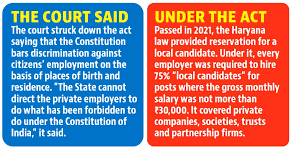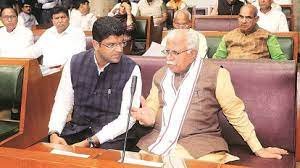
In a watershed moment, the Punjab and Haryana High Court, in a decisive move, has invalidated the Haryana State Employment of Local Candidates Act, 2020; effectively dismantling the 75% local quota for state residents in private sector employment. This landmark decision, delivered a mere twenty-four hours ago, has not only reverberated through the echelons of power but has also sparked fervent discussions on employment strategies, regional quotas, and the intricate interplay between legislative prerogatives and judicial interventions.
The Backdrop of 75% Local Quota
Under the now-defunct law, all private entities operating within Haryana were mandated to earmark 75% of newly created positions for individuals holding bona fide Haryana domicile. This legislative gambit, set into motion in 2020, sought to assuage mounting concerns about unemployment within the state and to ensure that economic avenues were accorded precedence for indigenous denizens.
Interrogating the Court’s Pronouncement
The High Court’s verdict, dismantling this legislative scaffold, propels us into a realm of profound inquiries concerning the constitutionality and pragmatism of regional quotas within the private sector. This adjudication, a blow to the Haryana government and Deputy Chief Minister Dushyant Chautala, lays the groundwork for a legal skirmish with ramifications extending beyond Haryana’s borders, potentially shaping the contours of employment regulations nationwide.
Legal Luminaries’ Perspectives Unveiled
Legal pundits have dissected the ramifications of the court’s edict. Advocates aligning with the verdict posit that it harmonizes with the tenets of equal opportunity and non-discrimination. They contend that private sector employment should be undergirded by meritocracy, and regional quotas might impede the overarching efficiency and competitiveness of corporate entities.
Conversely, some legal minds pose a pivotal question: should the judiciary intercede in what fundamentally amounts to policy decisions nested within the legislative domain? The discourse transcends Haryana, resonating with broader dialogues on the equilibrium between state autonomy and constitutional safeguards.
Government’s Resolution to Contest

In the wake of the High Court’s decision, the Haryana government has staunchly declared its intent to petition the Supreme Court. This strategic move underscores the government’s unwavering commitment to fortify its policy stance and raises the specter of a more expansive legal precedent, potentially influencing analogous regional quota statutes across the nation.
The government contends that such measures are indispensable to shield the aspirations of local job seekers, particularly in a fiercely competitive job market. It asserts that regional quotas act as bulwarks against disproportionate encroachment by migrants, ensuring that economic development redounds to the benefit of the local populace.
Industry Echoes and Apprehensions
The private sector, an integral player in this legal drama, has articulated a medley of reactions. While certain employers applaud the court’s pronouncement, citing the imperative for merit-centric hiring, others voice trepidation regarding potential repercussions from local communities and the resultant impact on workforce dynamics.
The legal ambiguity surrounding employment quotas has left myriad businesses teetering on uncertainty, grappling with the challenge of navigating their recruitment practices sans clear legislative guidelines.
Impact on Indigenous Employment and Economic Progress
Champions of the now-invalidated law posit its indispensability in safeguarding the interests of local job seekers amidst an intensely competitive job market. They argue that such measures are requisite to prevent job opportunities from being disproportionately siphoned by migrants, ensuring that economic prosperity is equitably shared with the local demographic.
Conversely, critics posit that regional quotas might breed inefficiencies in the labor market. They advocate for unbridled merit-based hiring, contending that the regulations of this industry could impede the holistic efficiency and competitiveness of enterprises.
Perturbations Anticipated in the Apex Court
As the legal saga advances to the Supreme Court, a tapestry of challenges and considerations unfolds. The apex court must scrutinize the constitutionality of regional quotas in private employment, delicately balancing the state’s authority to enact such laws against the fundamental right to equality for all citizens.
This case carries broader implications for employment laws in India, prompting contemplation on the extent to which states can regulate private sector hiring and the judiciary’s role in scrutinizing such policies. The verdict’s resonance could shape the future trajectory of employment regulations, establishing precedents for other states contemplating analogous legislation.
Wider Ramifications for Employment Legislation in India
The nullification of Haryana’s 75% local quota in private sector jobs by the High Court is a consequential chapter in the ongoing discourse on employment policies in India. As the legal saga unfolds in the Supreme Court, the nation watches intently, cognizant that the outcome may cascade into far-reaching consequences for the delicate equilibrium between state autonomy and the constitutional imperative of equal opportunities for all citizens.
In a swiftly evolving economic milieu, where coveted job opportunities are fiercely contested, the judiciary finds itself at the crossroads of interpreting laws seeking to redress regional imbalances while upholding the principles of fairness and equal opportunity. The impending Supreme Court ruling will not solely impact Haryana; its resonances will undulate nationwide, influencing the trajectory of employment laws within the private sector.
Conclusion

The annulment of Haryana’s 75% local quota in private sector jobs by the High Court marks a pivotal juncture in the ongoing discourse surrounding employment policies in India. It unfurls fundamental questions about the equilibrium between state intervention and the unfettered market, the judiciary’s role in shaping policy decisions, and the imperative for a standardized approach to employment regulations.
As the legal odyssey unfolds in the Supreme Court, the nation awaits, poised for a decision that not only shapes the future of employment laws in Haryana but also serves as a benchmark for analogous legislation nationwide. The ramifications are sweeping, transcending the legal arena to implicate economic development, labor market efficacy, and the pursuit of equitable opportunities for all citizens.










